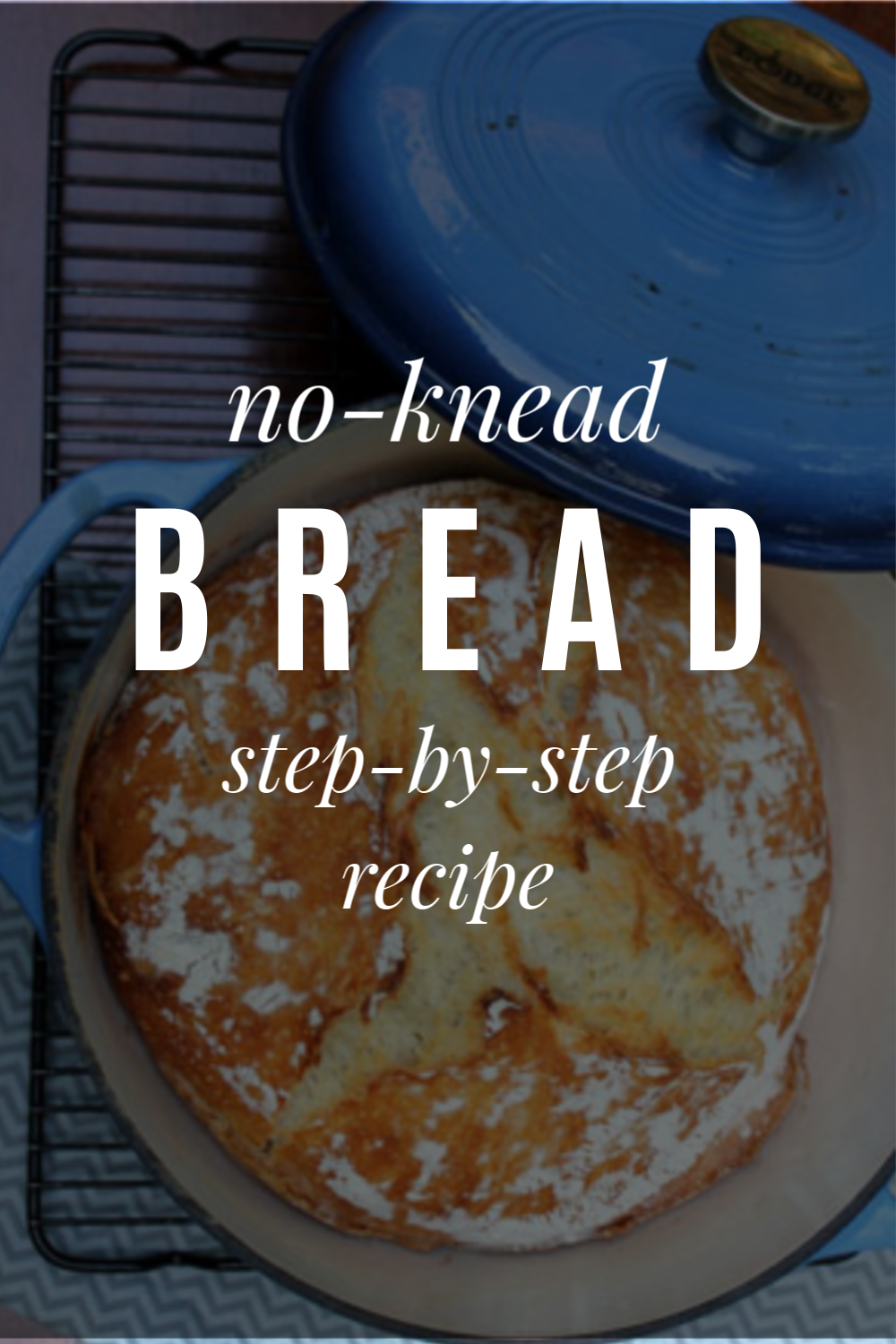
No-Knead Bread Recipe
If you have been hanging out around Frugal Living NW for awhile, you know that I am a big believer in making food from scratch at home. With a few exceptions, I prefer creating something in my own kitchen to buying it in the grocery store.
Bread can be tricky, though. There is some stiff competition out there, and it is tough to replicate a commercial oven’s heat and steam in a normal home kitchen.
For the last several years, I thought that Artisan Bread in 5 Minutes was the best thing since, well, sliced bread. It was simple, and we were content with the results. That is, until last summer when our neighbor brought over a beautiful, delicious loaf of home-baked bread. We had to know her secret. One phone call, and she came back with the book, My Bread by Jim Lahey (Amazon).
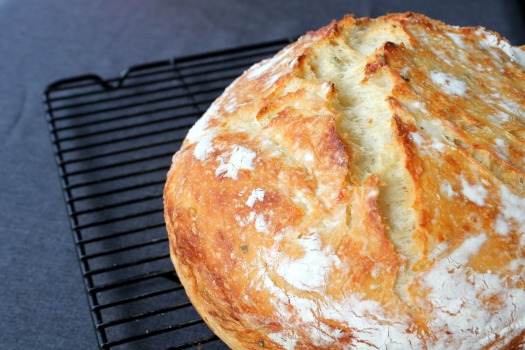
We have been baking bread using this method ever since. I can count on one hand the number of times I have bought bread in the store since then, because I can now make an artisan-quality loaf at home for a fraction of the cost.
I am telling you, this is consistently the best bread I have ever made in my kitchen. Okay, enough gushing. Let’s make some bread.
The only changes I have made to Lahey’s method is to double the amounts and adjust the baking time and temperature to achieve a bigger loaf with a thinner crust.
Oh, and don’t be put off by all these steps. This is totally possible for home bakers at any skill level. I wanted to give you the confidence to do this on your own. A concise recipe can be found at the bottom of this post.
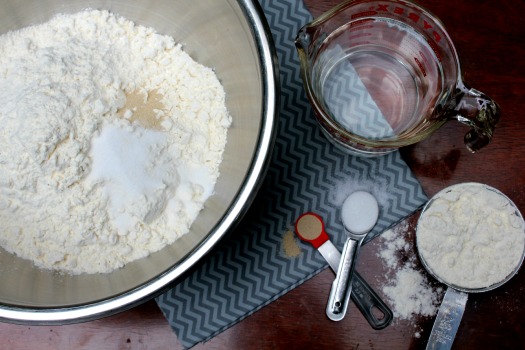
The ingredients are simple: flour, water, salt, and yeast. My husband calculated this bread costs 74¢ per loaf (using Bob’s Red Mill flour & Costco yeast).
Oh, wait! Don’t forget to factor in the roughly 8 cents of energy used to bake it for an hour. No, I’m serious. My husband really does think about this stuff! He’s funny.
So, there you go. A whopping 81¢ for a substantial 2.5 pound loaf of bread. That is crazy cheap.
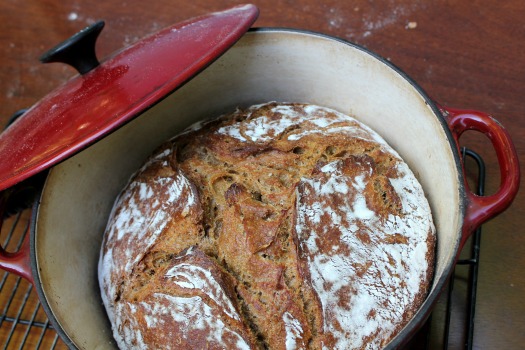
If you want to use some whole wheat flour, substitute 3 cups of whole wheat for 3 cups of the all-purpose flour (3 cups whole wheat and 3 cups of unbleached flour for a total of 6 cups) and add 3 Tablespoons of molasses (optional). This will produce a slightly sweeter, denser loaf of bread. Delicious.
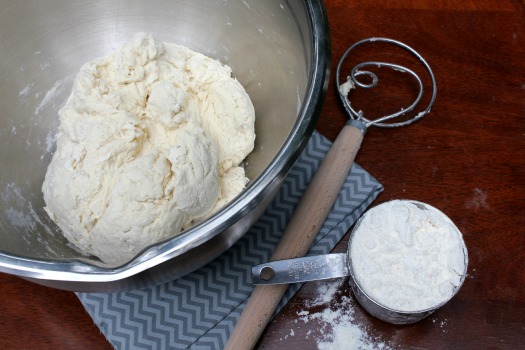
Combine the dry ingredients, add the water, and stir to combine (the funky looking wood-handled item is the amazing Danish Dough Wisk — makes stirring stiff dough a snap). The dough should be wet and sticky. Depending on the temperature and humidity in your home, you may need to add a little more flour or water, 1 Tablespoon at a time. So far, these steps are exactly the same as the 5 Minute method.
The main differences are that you use significantly less yeast (1/2 teaspoon vs. 1 1/2 Tablespoons) and significantly more initial rise time (12-18 hours vs. 2 hours).
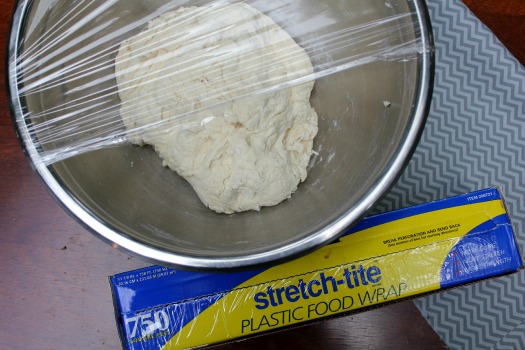
Once the ingredients are completely combined, cover the bowl with plastic wrap and leave it on the counter to rise for 12-18 hours. This slow rise aids in the fermentation of the yeast, giving the bread a better flavor.
Okay, I know what some of you are thinking: 12-18 hours! That’s ridiculous! Who has that kind of time?! I get it.
However, here are two things to consider:
- Once you get into a rhythm of baking your own bread, it’s not a big deal. I start mine in the afternoon or evening and bake it the next morning or afternoon. This would also be an easy weekend routine.
- Just like the title claims, this bread requires no kneading. It is not fussy, temperamental dough. You can produce a delicious loaf of bread with very little hands-on effort & experience.
You’ll know your dough is ready when it has risen in the bowl, smells yeasty, darkened slightly, and is covered with small bubbles.
Using well floured hands, shape and tuck the sticky dough into a rough ball. You can also fold it over a couple times on a well-floured surface. It doesn’t have to be perfect; just keep quickly tucking the dough underneath with your fingertips until you have a semi-smooth dough ball. The dough should be wet but manageable; you don’t want a wet blob so sticky that you can’t shape it into a ball.
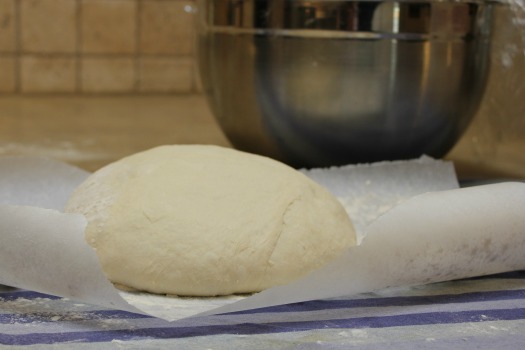
Take a clean linen or cotton tea towel (not terry cloth) and dust it with flour, cornmeal, or wheat germ to prevent the dough from sticking to the towel as it rises. You can also use a floured square of parchment paper on the towel to make the dough ball easier to handle. Place the dough ball, seam side down, in the middle and dust with more flour.
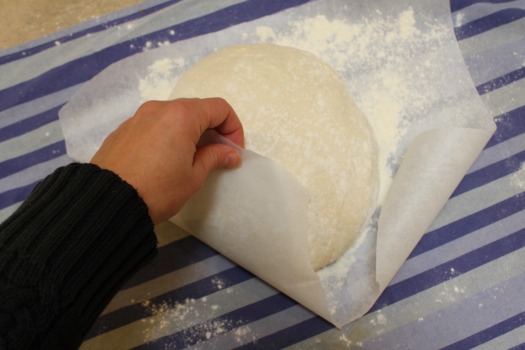
Cover the dough with the (parchment paper and) towel and let it rise for 1-2 hours at room temperature, until doubled in size. During the last 30 minutes of rise time, place a heavy lidded 6-8 quart pot, like a Dutch oven, in a cold oven and preheat it to 425 degrees.
Confession: I own three Dutch Ovens. I use them all the time. They are incredibly versatile and worth the investment. If you don’t own one, you could also make this in any lidded pot, provided it is oven-safe at such high temperatures. Also, check the knob on your pot. If it isn’t rated for such high heat, you’ll want to remove it or cover it with foil. You can also buy an inexpensive replacement knob that is rated for higher temps!
Okay, this is the trickiest part of the entire operation. Remove the lid from the piping hot Dutch Oven, slide your hand underneath the towel or parchment paper, and flip the risen dough (seam side up now) into the pot. Try to flip close to the pot or the flour will fly everywhere. Remove the towel or paper and set aside.
This might take a bit of practice, but again it doesn’t have to be perfect. Some of my worst flips have produced my most beautiful loaves. I love what Lahey writes, “…even the loaves that aren’t what you’d regard as perfect are way better than fine.”
Place the lid back on top and slide the pot back into the hot oven.
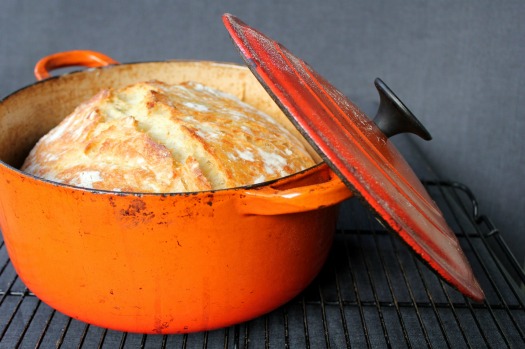
Bake it for 40-50 minutes. Remove the lid. Bake for another 5-10 minutes, until golden chestnut brown. The internal temperature should be around 200 degrees. You can check this with a meat thermometer if you’re nervous about knowing when your loaf is done.
Oh man, your house will smell so good about right now.
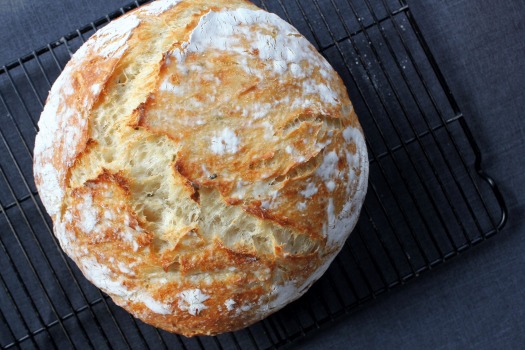
Place the loaf on a cooling rack. You will hear it crackling as it cools. Use every ounce of self-control to resist cutting into it until it is “quiet”; cutting it too soon will make the bread dense and gummy.
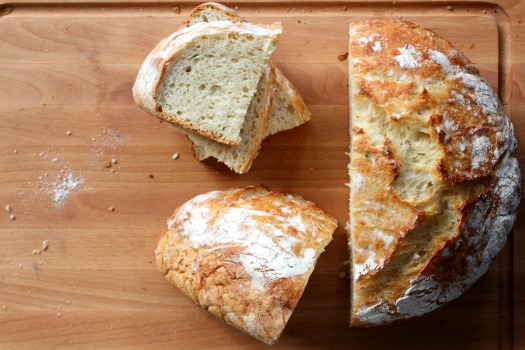
This bread is best the first 2-3 days. I just store my leftover loaf inside the Dutch oven on the countertop. Using plastic wrap will soften the crust. Dry, leftover bread makes great bread crumbs, toast, French toast, or croutons!
Enjoy. And pat yourself on the back. You just baked an amazing loaf of bread!
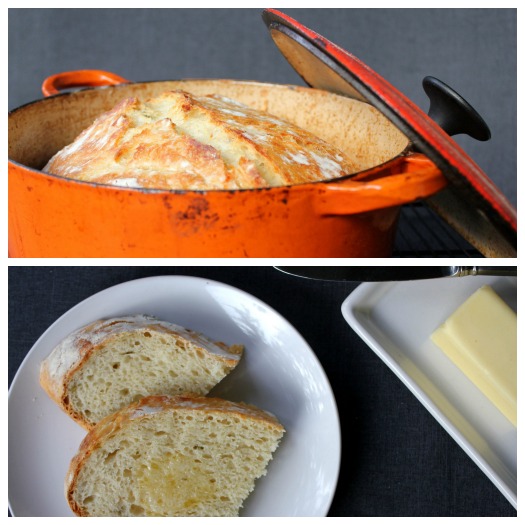
Basic No-Knead Bread
Slightly adapted from Jim Lahey’s My Bread
Ingredients
6 cups bread flour (recommended) or all-purpose flour, plus more for work surface
1/2 t. instant or active-dry yeast
2 1/2 t. salt
2 2/3 c. cool water
- In a large bowl, combine the flour, yeast, and salt. Add the water and stir until all the ingredients are well incorporated; the dough should be wet and sticky. Cover the bowl with plastic wrap. Let the dough rest 12-18 hours on the counter at room temperature. When surface of the risen dough has darkened slightly, smells yeasty, and is dotted with bubbles, it is ready.
- Lightly flour your hands and a work surface. Place dough on work surface and sprinkle with more flour. Fold the dough over on itself once or twice and, using floured fingers, tuck the dough underneath to form a rough ball.
- Place a full sheet/large rectangle of parchment paper on a cotton towel and dust it with enough flour, cornmeal, or wheat bran to prevent the dough from sticking to the parchment paper as it rises; place dough seam side down on the parchment paper and dust with more flour, cornmeal, or wheat bran. Pull the corners of parchment paper around the loaf, wrapping it completely. Do the same with the towel. Let rise for about 2 hours, until it has doubled in size.
- After about 1 1/2 hours, preheat oven to 425 degrees. Place a 6-8 quart heavy covered pot, such as a cast-iron Dutch oven, in the oven as it heats. When the dough has fully risen, carefully remove pot from oven. Unwrap the towel and parchment paper from around the dough and slide your hand under the bottom of the dough ball; flip the dough over into pot, seam side up. Pull the parchment paper off, scraping any stuck dough into the pan. Shake pan once or twice if dough looks unevenly distributed; it will straighten out as it bakes.
- Cover and bake for 40 minutes. Uncover and continue baking for 10-15 more minutes, until the crust is a deep chestnut brown. The internal temperature of the bread should be around 200 degrees. You can check this with a meat thermometer, if desired.
- Remove the bread from the pot and let it cool completely on a wire rack before slicing.
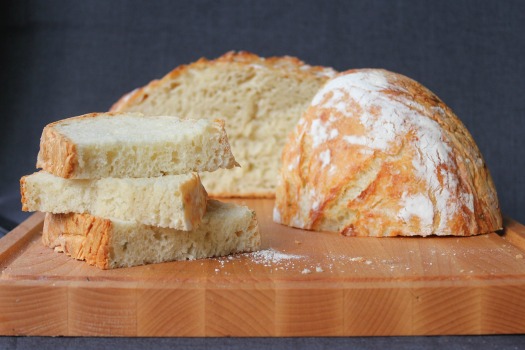
Here are a couple options for Dutch Ovens. Any heavy, lidded 5-8 quart pot (seasoned cast iron or enamel coated) would work with this recipe. Lodge has the best prices/options for dutch ovens on Amazon.
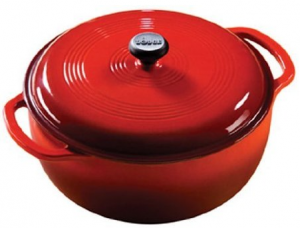
Lodge Logic Dutch Oven in Island Spice Red (6 Quart)
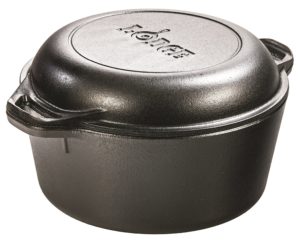
Lodge Cast Iron Double Dutch Oven (5 Quart)
If you already have a dutch oven (or find a deal on a lesser-known brand) that doesn’t have a knob rated for high temps, replace it! There are some really affordable options.
Got questions? You are in good company. Go here for the complete FAQ list.
Looking for more variations to the no-knead bread recipe? We’ve created a list with sweet and savory varieties, including the following:
- Cranberry Orange
- Four Cheese
- Sandwich Bread
- Dark Chocolate Coconut
- Tomato Basil Cheese
- Whole Wheat
Looking for more delicious bread recipes?
Find more delicious recipes on our Recipe Page!
Follow Frugal Living NW on Pinterest!
Fantastic range of boards from best recipes and tips for frugal living to gardening and budgeting help.
This post may contain affiliate links. See the disclosure policy for more information.
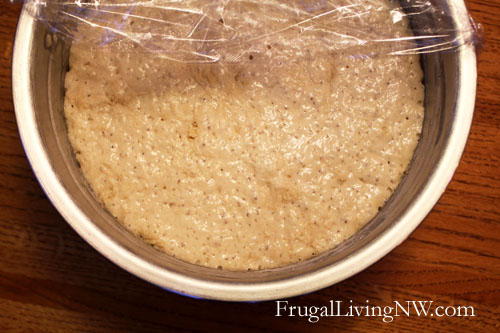
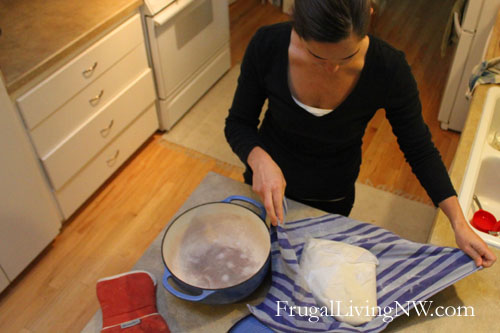
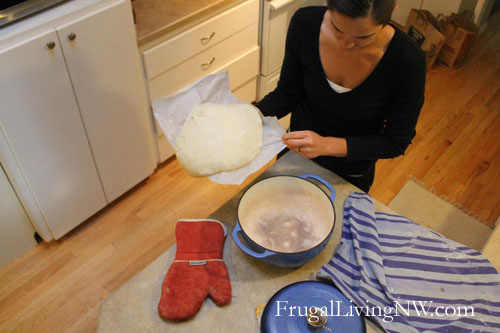

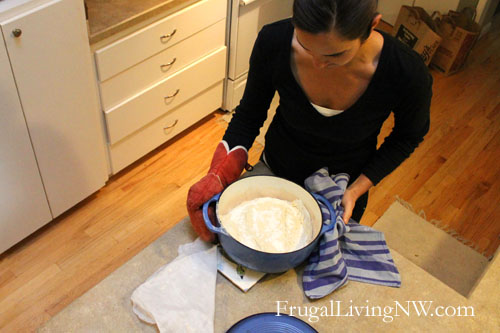


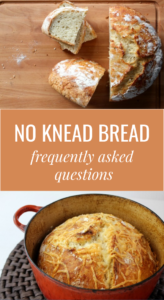
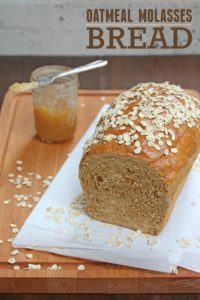
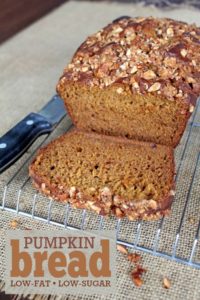
How about some tips for high altitude? I am a mile high and didn’t rise quite like I wanted. Also, love ol
I put the dough together last night and when it was ready, I cut off a hunk and spread it out to experiment with it as a pizza crust. This made a delicious Pizza Margherita! My husband absolutely loved it. Can’t wait to get the bread baking, but I’m waiting for my daughter to deliver her Dutch oven. I wanted to borrow hers instead of investing in one before I knew if I could do this, or not. If the bread is anything like the pizza, I will be buying one making this regularly. Thanks!
If you want to make any bread taste richer use some Saco’s Buttermilk Powder. In this recipe I would start with 6 Tbls. and adjust from there.
Finished making this today. Unbelievably easy, baked up with a beautiful crust and crumb (I live at 7000 feet and had to bake this for 70 minutes), but it’s lacking something in the flavor. Maybe a touch of sugar or a bit more yeast? It’s rather flat. Also, I didn’t oil the pot. Big mistake. It’s stuck firm.
I recommend making your own artisan gluten free flour mix from a book my Peter and Kelli Bronski. The piecrust is incredible and the gf flour is worth putting together.Should do a GRAND bread.
As a rise time reference – I made this wonderful recipe and I subbed 2 cups whole wheat for 2 cups of the unbleached all-purpose flour. I added 1/4 cup honey. I whisked the dry ingredients first. After stirring in the water and honey I felt the dough was ‘unformed’ which is my way of saying it looked a little dry. I didn’t add anything but I did fold it over about 8 times then started the rise in a bowl sprayed with Pam.
My kitchen started at 79F and went to 82F over the 13 hour rise period. I kept looking for the dough to get “Darker” but it didn’t appear to darken at all. What I DID see as I looked closely were the many bubbles just ready to burst through the dough – because of the wheat flour you have to really look for these – but they look like the un-popped bubbles on a pancake just before you flip it.
That dough rolled right out of the bowl. I did fold it again 4 times and then did the tuck but it came out just as smooth a ball of dough as you have ever seen. Another rise of 2 hours. After baking the bread had the most uniform grain to it and disappeared in a day. ‘Course one of the eaters is our son, a 21 year old U.S. Marine, sooo….
This recipe is so good. I have made it several times to rave reviews and I have passed it on to several people. Really good as cinnamon toast. Thanks for making a baking idiot look like a master.
Ok, This bread is amazing! First time ever making bread of any kind and it came out perfect.
Adding ingredients to make different types of bread –
To those of you adding ingredients – when and how do you add the ingredients in the process?
At the beginning by stirring it in? After the first rise by kneading or folding them in?
I am thinking of making the whole wheat variety with craisins and chopped walnuts. Any thoughts as to when best to add?
I added my ingredients (except the jalapeno which I put on the outside of the bread) at the time I mixed it all up. When I used the steel cut oats I toasted them a bit before I added them at someone else suggestion. When I used jalapeno I put it all over the outside on the second rising.
Thank you, Tammy. I think I will try adding the ingredients at initial mix, as well. Will leave results here.
Love the idea of walnuts and craisins! Keep us posted on how it comes out 🙂
To those of you learning how to bake bread…recipes are nearly exact in the amount of ingredients… but the timing and temperatures are merely guidelines. (Well, I DO use a thermometer to check for doneness.)
Room temperatures vary in my house by up to 15 degrees in a day. That is huge for a rise of 10+ hours.
Oven temperatures vary also – I check my oven for accuracy using a digital thermometer and I check it at 300F and at 450F to see if or how it varies. In my case, even with a “digital control panel” I find the actual temperature is 5 to 7 degrees warmer than the control. It’s what you get when you work with mechanical stuff.
Go with the descriptions of when the rise is done and you will probably not have an issue with the “slimy, runny mess”. If you are seeing free liquid on top of the rise my bet is you went too long.
A suggestion might be to print the recipe and make notes – for instance the room temperature when you set the dough to rise – especially if you make it during different seasons. I take pictures of my bread baking – so I have a visual reference for it. The neat think about this recipe is you don’t have to learn the feel of kneading (though I enjoy it, actually).
Anyway, thoughts on when in the process it is best to add ingredients in this recipe? To those of you adding ingredients – when and how do you add the ingredients? I am thinking of making the whole wheat variety with craisins and chopped walnuts. Any thoughts as to when best to add?
To those of you adding ingredients – when and how do you add the ingredients? I am thinking of making the whole wheat variety with craisins and chopped walnuts. Any thoughts as to when best to add?
To those of you learning how to bake bread…recipes are nearly exact in the amount of ingredients… the timing and temperatures are merely guidelines. (Well, I DO use a thermometer to check for doneness.) Go with the descriptions of when the rise is done and you will probably not have an issue with the “slimy, runny mess”. If you are seeing free liquid on top of the rise my bet is you went too long.
A suggestion might be to print the recipe and make notes – for instance the room temperature when you set the dough to rise – especially if you make it during different seasons. I take pictures of my bread baking – so I have a visual reference for it. The neat think about this recipe is you don’t have to learn the feel of kneading (though I enjoy it, actually).
I have made it with Steel cut oats, wheat berry and even a jalapeno cheese variety. It is awesome!
Just made this today for the first time. I used 2 cups of white whole wheat flour and 4 cups of bread flour. After the overnight rise, it was very wet as some have said. I kneaded in enough more flour to give it more body, then proceeded as the recipe says. It came out great! Can’t wait to add herbs etc another time.
Mine doesn’t pour out and it is sticky too. I have to put both hands in and pull it away from the bowl and then fold it over and put it on the floured towel. It sticks on the side but not enough usually to worry about.
Hi –
I’ve got this bread on the second rise now and am SO excited to try it! I bake bread all the time – in my breadmaker. I’m really looking forward to trying this one without the breadmaker.
One problem though – when I tried to “pour” it out of the bowl it had risen it, it was SOOOOO sticky and a lot of it got left in the bowl. Should I have greased the bowl before I put the dough in it? I just used the same bowl I mixed it in… should I have used a different greased bowl?
Another way to ease it into the hot dutch oven is to let is rise on a piece of parchment paper that has been cut to fit in the bottom of the dutch oven with a nice edge to grab to slip it into the hot pan. There are just two of us at home now, it’s easy to reduce the size of the loaf to meet our needs. Thanks for sharing.
Anyone try gluten-free flour yet? And if so, how did it turn out? I’d love to hear feedback about this…:-)
May I add yet another tip…I ran out of cornmeal one day and used sesame seeds to keep the dough from sticking to the towel…oh man!! Use it all the time now!!
Absolutely Fantastic! I made the mistake of not reading all the comments before I started this, so I was using the suggested time for the first rise… not a waste, but VERY wet. After the 2nd rise, when going to put the bread in the pot I realized the dough had stuck to the towel…. again, not a problem, just got as much off as I could, covered & baked. Hardest part BY FAR was waiting for the cracking noises to stop so I could eat it! I’ll never use another bread recipe again! Thank you!! Next time I’m going to add some herbs, maybe some cheese… then, maybe cinnamon and brown sugar…. I can see no dieting is in my future!
I made this bread over the weekend and I have to say that it turned out beautifully! I even liked the long rise time as I was able to make the dough, leave it over night and then have the smell of fresh baked bread in the morning. Next time I’ll let it brown more at the end for a bit more of a hard crust but a fantastic recipe nonetheless!
I would just like to say that I have now done this bread 3 times and it has come out insanely wonderful every single time! I found your step by step tutorial very helpful. I know this is going to be a staple in my house from now on!
I just made my first loaf….it was wonderful…thanks
If the bread is getting too dark just cover it with a cloth to finish cooking .
I was making this today- I originally used Mother Earth News’ recipe, but I remembered yours was roughly doubled and wanted to give it a shot since my dutch oven is bigger than the one called for and my loaves were always done long before the time was up. I added some whole wheat flour and was REALLY tempted to add some quinoa I had in my fridge for extra texture… but have never just “thrown” in quinoa with yeasted breads… any thoughts? Should I use it as a substitute for flour, or just add it in like you would herbs, cheeses, etc?
I have never made bread before, so perhaps maybe I just don’t know how to do it correctly..I followed this recipe to a T, and after 12 hours, i turned the bowl over it is a watery, slimy, runny, mess. I just put it back in the bowl & covered it again…. Is there anything I can do to save it??? Help please!!
Erin, see comments above on over-proofing. I am no expert but my experience has been that once the dough sits too long what you experienced happens. I have had limited luck saving it so just start over. Not so say you couldn’t try by adding more yeast and some flour to get it back to a stiff/sticky consistency.
Hi! My family owns a bakery in Italy but when I moved to the States I missed the good family bread! I found this recipe almost one year ago and I LOVELOVELOVE it. I just want to let you know that if you dont have a dutch oven, you can cook the bread in a normal pan, I use a big one for pizza with no boarders so that the bread “feels free” to grow into the shape it likes! So as I was saying I cook it into a normal pan, for about 30-45minutes (it depends on the loaf) in a preheated oven at 400 degrees and I put in the oven a bowl (metal or pyrex) with some water and I leave it in there for the whole time (since I start preheating until I turn off the oven). The humidity helps the bread to get the nice golden color and keeps the humidity constant, this is a baker trick! Every one should try to make this bread even if they don’t have a dutch oven!
The bread is delicious but mine definitely burned! I had a hard time getting it out of the pan. I baked at 430 for 45 minutes and then 5 minutes without the lid. Next time, I’ll set the temp lower and only bake 40 minutes. Otherwise, amazing!
I set my oven at 420 based on other comments and 50 minutes covered and 5 minutes uncovered gave an excellent golden brown loaf. The type of pan that you are using (cast iron, cast aluminum or something else) will also have an impact. I used a cast aluminum pan. Experiment and you will quickly figure it out.
Ok, I tried this and I was so excited. I followed the recipe exactly and let it rise for 14 hours. When I turned the bowl over to put it On the counter it was a watery, runny mess. 🙁 I didn’t have any cling wrap to cover the bowl, but the my mixing bowls have lids so I used that instead. Was that a mistake?
Could be it over-proofed. I find in the summer it doesn’t take as much time. Try 10-12 hrs.
I would agree with Joie’s assessment.
I made this for the first time last night/today and only let it rise for about 9-9.5 hours. Go more by the look and smell described than time. The temperature outside and in your house will make a big difference. With experience in making bread, you will figure it out!
Sounds easy enough….thanks for posting! So, if I want to use whole wheat flour, am I supposed to use 3 cups whole wheat and 3 cups all purpose flour? Or just 6 cups whole wheat flour…along with the molasses…? Thanks for any tips…I’m a novice!
will glass cookware such as corning ware work instead of the cast iron?
I just made this tonight, and I am seriously dying, it is so good!!! I have never baked my own bread before, other than banana and zucchini bread. I will never buy it again. Love it toasted with butter and strawberry preserves. Absolutely amazing, I cannot thank you enough!
Since I have posted, initially I have used my baking stone with wonderful success! I have tried LOTS of pinterest bread recipes and this one is by far our favorite. Especially love it as it doesn’t have the yeasty taste like some that require so much more yeast. Has anyone tried making it in a loaf pan? That may be my next experiment! Thanks for sharing this recipe …. I think I’ll be using it a lot!
do you put a pot of water in the oven when you bake it?
No need! The dutch oven (or lidded pot) traps all the steam (moisture released from the bread while baking), giving you that crisp crust that some recipes achieve by spraying or placing a container of water in the oven. Hope that helps!
Do you let it rise the second time on the stone or do you still put it in a towel, preheat the stone and then “flop” the dough on the preheated stone?
Sheila, I think the official way to do it is to let it rise on a pull (a big flat wooden paddle) with some cornmeal/wheatgerm/flour underneath it and then slide it onto the stone when it’s ready. The stone is preheated in the oven.
Thank you so much for putting this recipe out there, Kim! Like another person who commented, I’ve tried a few bread recipes from Pinterest. This is the only one that turned out good and the whole family enjoyed it. I’d love to try it with Rye or by adding herbs. If anyone has tried this I’d love to know.
Hi!
I love rye! I tried it using a 1:2 ratio. One cup of rye for every 2 cups of regular flour. I also added 1TB of caraway seeds. It turned out great!
i tried it with rye flour (same 1rye:2white ratio) but i also added 3 tablespoons of brown sugar which gave it a sweet malty undertone! really good. my german housemate said it reminds her of bread from home.
I made this tonight and it was so wasy and tasted incredible!
Hey! I have made this bread 5 different times, I think it’s fool proof! I make it in my bbq that has a temperature gauge on the outside so it doesn’t heat up the whole house. I have made it 100% whole wheat, while exchanging 1/4 cup of flour with 1/4 a cup of vital wheat gluten. This was also in the bbq. Thank you so much! I make a loaf almost every day! ( The bbq cook times and temps are the same.)
The bottom of my loaf gets too dark. I have adjusted rack height and temp with no luck. Suggestions?
Do you know of any changes for high altitude? I live above 5000 ft. and some recipes need a slight modificaion.
No modifications are needed. Your rise times will likely be faster, but the recipe gives you a nice, long window so you should be fine! My sister made this recipe as written at 8,000 ft. with no problems. Hope that helps and happy baking!
I made this with the white flour last week. I loved it, my husband loved it and my son loved it. SCORE! I mixed it with 3 cups wheat flour this time and the suggested molasses. I’m curious. Why molasses when using wheat flour?
It’s not necessary, but we think the molasses flavor goes well with the heavier wheat flour. Adds a nice sweetness to a denser loaf. Feel free to omit it if molasses isn’t your thing!
Made this today. It was a huge hit! I can’t wait to experiment with adding herbs to the bread. I made the dough yesterday and let it sit overnight and baked it this afternoon. I WILL be making this one again. Thanks!
Yay! I was so excited to watch my bread raise and bake and look like restaurant style bread!
I substituted 3 cups of white flour for the whole wheat flour and found I needed a bit more water – is that correct or did I measure wrong? Also, the crust was a bit chewy – is that a result of using the wheat flour?
Thanks for your great blog – I love pictures 🙂
Blessings,
Sam
Sounds like you did everything right! Every now and then I add a bit more water or flour, if the consistency of the dough seems a bit off. It always comes together as it rises, though, so it’s hard to go wrong with just slight adjustments.
The crust will be crisp when you first pull it out of the oven. After the second day, it will be more on the chewy side.
I’m going to try this with my gluten free flour, I’ll let you know how it works. I really, really miss bread. Especially good bread. Also wondering if you’ve ever added herbs, minced garlic, etc, and with what success. I can’t imagine them changing it much. Also, I’m going to halve your recipe, what size dutch oven did it originally call for? I’m guessing 3-4 qt? Thanks for sharing, I can’t wait to try it.
Lahey’s original recipe (half of this one) was developed using a 4 1/2 – 5 1/2 qt. pot. Something in that range should work just fine!
Also, I have added cheese, herbs, and roasted garlic with great results (as I am shaping it for the first rise on the towel)! This recipe is open to creativity!
Have you tried this yet? I miss BREAD and real pizza!
Question for Cassi: Did you try it with your gluten free flour? How did it turn out?
Have you ever used a baking stone (with a pan of water on the lower shelf) instead of a dutch oven?
Yes, Michelle. I use a baking stone with my grilling pan just below it. I fill it with about 2 cups of water and preheat the oven. Then I add another 1-2 cups of cold water just before putting the bread in and I do my best to trap the moisture in the oven. You can NOT preheat Pampered Chef stones but some others you can but I would check the manufacturer. I make this recipe into french baguettes with the stones and it is fantastic.
One more question. I bought a dutch oven today, didn’t pay attention to the size of the DO you put in your recipe. The one I bought is 5 quarts & that’s the only one they had at Walmart.
Will a 5 quart still work? I can look around for a 6-8 quart. I haven’t opened the DO yet, I can always return it. It seemed like a good buy @ $35 something
That’s a great price. I’d hang on to it and give it a shot. If it turns out to be too small of a pot, you could always cut the recipe in half for a smaller loaf.
Take this advice with a grain of salt, though, as I have a serious weakness for Dutch ovens… 🙂
Do you put any oil in the Dutch oven?
Tamara & Kim – No, you don’t add any oil to the Dutch oven. The preheated pot will give your dough a nice crust that will pop right out of the pot at the end of the baking time.
I recommend oiling the pot. I used a Le Creuset, and while it baked up beautifully, it stuck fast to the bottom.
Do you need to grease or spray the cast iron pot before inserting the dough?
Just gotta say it… found your recipe on Pinterest and if you look at how many bread recipes are on my Breads & Dessert board, you would be shocked. I have probably tried at least 10 of them and NEVER had success… until this one! Not only did it work, but it is TO DIE FOR! I substituted one cup bread flour for one cup whole wheat and added a tbl of molasses as you suggested, and WOW! I am so excited to finally have succeeded at making my own bread. I am now finally encouraged, instead of discouraged. I was about to give up but NOT NOW. What is funny is that my dough stuck to the towel and about a cup of it ended up staying there. After I got the dutch oven in the oven, I scraped it off the towel, made a ball out of it, let it rest for 20 minutes or so, and put it in a small cast iron skillet. I stuck in the oven for about 10 minutes AND WOW! It was as good or better then the original … in other words, this is almost fool proof. Thanks for sharing.
Just put mine in the oven. Didn’t have a dutch oven or oven safe pot, so I threw it on my pizza stone. We’ll see what happens!
Keep us posted!
I just took mine out of the oven. I listened to you…it is a work of art! Thanks.